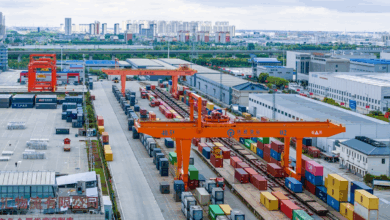U.S. Tariffs on Chinese Goods Create Opportunities for Thai Exports and Industries

The recent hike in U.S. tariffs on Chinese goods has reshaped trade dynamics, presenting both challenges and opportunities for Thailand’s export and industrial sectors. This article explores how these changes are influencing Thai industries, detailing the potential benefits and strategic adjustments required to navigate the new trade environment.
Impact of US Tariffs on Thai Export Opportunities
Boost in Thai ‘Summer Products’ Exports
The recent increase in U.S. tariffs on Chinese goods has inadvertently boosted the export of Thai ‘summer products’. Exports of these products have seen a 13% year-over-year increase, reaching a total of US$1.27 billion. This surge is attributed to the shift in market demand away from Chinese products due to higher costs.
Shift in Global Manufacturing to ASEAN
As tariffs make Chinese goods less competitive, global manufacturers are looking towards ASEAN countries, including Thailand, as alternative production bases. This shift is expected to bring more manufacturing jobs and technology transfers to Thailand, enhancing its industrial capabilities.
Increased Foreign Direct Investment
The trade tensions between the U.S. and China are prompting companies to diversify their investments into more stable and welcoming environments. Thailand, with its strategic location and growing economy, stands to benefit from increased foreign direct investments aimed at avoiding tariff-laden Chinese markets.
Challenges Facing Thai Industries Amidst US-China Trade Tensions

Dependence on Chinese Supply Chains
The intricate dependence on Chinese supply chains poses a significant challenge for Thai industries. Many sectors are intertwined with Chinese manufacturers for raw materials and components, making them vulnerable to disruptions in these supply chains.
Competition with Neighboring ASEAN Countries
Thai industries face stiff competition from neighboring ASEAN countries, particularly in sectors like automotive, where Thailand recently lost its position as ASEAN’s second-biggest auto market to Malaysia. This competition pressures Thai industries to innovate and improve efficiency.
Economic Slowdown in China Affecting Thai Exports
The economic slowdown in China, a major export destination, directly impacts Thai industries. A reduced demand from China can lead to significant declines in Thai exports, particularly in sectors heavily reliant on Chinese buyers, such as textiles and garments.
Potential Benefits for Specific Thai Industries

Textile and Garment Industry
The textile and garment industry in Thailand could see a resurgence due to shifting supply chains away from China. Increased tariffs on Chinese goods make Thai textiles more competitive globally, potentially increasing exports and job creation in this sector.
Electronics and Components
Thailand’s electronics sector stands to benefit significantly from the relocation of production bases to ASEAN countries. This shift is primarily due to increased foreign direct investment and the country’s established infrastructure in electronics manufacturing.
Agricultural and Processed Food Exports
The agricultural and processed food sectors in Thailand are poised for growth. With its rich agricultural base, Thailand can enhance its processed food industry, which is labor-intensive and supports large employment. The sector’s growth is vital for transitioning from traditional agriculture to more industrialized forms of production.
Strategic Adjustments in Thai Economic Policies
Trade Agreements and Negotiations
Thailand is actively seeking to bolster its trade relations through new agreements and renegotiations of existing ones. This strategic shift aims to mitigate the impacts of global trade tensions and secure more stable economic partnerships.
Industrial Upgrading and Technology Transfer
To maintain competitiveness, there is a focus on upgrading industrial capabilities and embracing technology transfer. Efforts are concentrated on sectors like electronics and automotive, where technological advancements are critical for growth.
Diversification of Export Markets
The Thai government is emphasizing the diversification of its export markets to reduce dependence on traditional partners. Exploring new markets in Africa, Latin America, and Central Asia could help buffer against fluctuations in major economies like the US and China.
Long-term Economic Implications for Thailand
Sustainability of Growth Amidst Global Tensions
The long-term economic growth of Thailand faces significant challenges due to global tensions and internal disparities. Sustained growth will depend heavily on the country’s ability to navigate through these geopolitical uncertainties and maintain a balanced economic policy.
Balancing Trade Between the US and China
Thailand’s trade strategy will need to delicately balance its relationships with both the US and China. The country’s increasing dependence on the Chinese economy is a concern, especially given the fluctuations in China’s economic health. Strategic diversification and fostering relationships with other trading partners will be crucial.
Future Projections for the Thai Economy
Looking ahead, Thailand’s economic trajectory is expected to see modest growth rates. Factors such as public debt, which has increased significantly in recent years, and the slow recovery of global trade will play critical roles. The government’s ability to implement effective fiscal policies and attract foreign direct investment will be key to securing a stable economic future.
Opportunities for US Businesses in Thailand
Market Entry Strategies
The U.S. Embassy Bangkok seeks to enter into contracts with qualified firms, highlighting the potential for U.S. businesses to expand their presence in Thailand. Strategic partnerships and understanding local regulations are crucial for successful market entry.
Challenges for US Exporters
Navigating the complex regulatory environment and intense competition from both local and international companies pose significant challenges for U.S. exporters. Adapting products to meet local consumer preferences and standards is essential.
Consumer Market Trends
The consumer market in Thailand shows a growing preference for high-quality, imported goods, particularly in the food sector. U.S. businesses can capitalize on this trend by offering products that align with Thai consumer preferences, such as organic and health-oriented products.
A Comparative Analysis of ASEAN Market Dynamics

Thailand vs. Malaysia in the Auto Industry
The rivalry between Thailand and Malaysia in the ASEAN automotive industry is well-established. Often dubbed the ‘Detroit of Asia’, Thailand boasts a robust automotive sector with a highly developed supply chain and substantial export capabilities. On the other hand, Malaysia’s automotive market is more domestically oriented, with strong national brands like Proton and Perodua dominating the landscape. While Thailand’s export-focused auto industry faces potential hurdles due to shifting global demands, it simultaneously presents significant growth opportunities, particularly in the burgeoning electric vehicle sector.
Role of Vietnam and Other ASEAN Countries
Vietnam’s role in the ASEAN region has been expanding, particularly in manufacturing and exports. The country has benefited from the shift in global manufacturing to ASEAN, driven by its competitive labor costs and growing industrial capabilities. Other ASEAN countries, like Indonesia and the Philippines, are also seeing increased investment and development, positioning the region as a key player in global supply chains.
Impact of Tariffs on Regional Trade Patterns
The imposition of tariffs has significantly altered trade patterns within the ASEAN region. Countries like Vietnam and Thailand have seen an increase in exports as businesses look to circumvent tariffs in major markets like the US and China. However, this has also led to increased competition among ASEAN countries, which are striving to attract foreign direct investment and boost their manufacturing sectors.

Conclusion
The significant increase in U.S. tariffs on Chinese goods presents a complex landscape for global trade, yet it opens a window of opportunity for Thailand. As industries and exporters in Thailand navigate the challenges posed by these changes, they stand to gain from the redirection of trade flows and increased foreign direct investment. By capitalizing on these shifts, Thailand can enhance its economic resilience and potentially secure a more favorable position in the international market. This scenario underscores the importance of strategic adaptation and the potential for emerging markets to benefit amidst global economic shifts.















